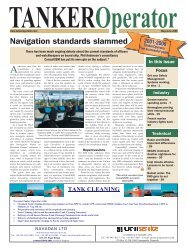Features: - Tanker Operator
Features: - Tanker Operator
Features: - Tanker Operator
You also want an ePaper? Increase the reach of your titles
YUMPU automatically turns print PDFs into web optimized ePapers that Google loves.
TECHNOLOGY - EMISSIONS<br />
To coke or hydrocrack the residual oil and<br />
thereby convert this to distillate.<br />
Or simply use more crude oil to produce<br />
more distillates.<br />
The latter imply that several hundred million<br />
tonnes of additional crude oil will have to be<br />
supplied each year. The former imply that the<br />
residual oil must be exposed to high<br />
temperature, pressure and large amount of<br />
hydrogen, to be converted to lighter products.<br />
Clean Marine claimed that compared to the<br />
distillate option, installation of EGCS in the<br />
form of scrubbers, represents a superior<br />
alternative;<br />
Higher cleaning efficiency unless the<br />
prescribed distillate has ultra low sulphur<br />
content.<br />
Less costly alternative.<br />
Less CO2 footprint.<br />
Better use of scarce petroleum resources.<br />
A ship or a marine installation has sufficient<br />
manpower and infrastructure to operate and<br />
maintain advanced EGCS. In that respect<br />
there is little difference between such facilities<br />
and factories, or power stations ashore.<br />
Description<br />
Being a retrofit or a newbuilding installation,<br />
the exhaust from all sources on board is drawn<br />
through one cleaning unit by a fan installed<br />
after the unit.<br />
The fan is dimensioned to take the highest<br />
relevant accumulated engine loads –<br />
propulsion engines plus auxiliary engines,<br />
plus boiler, as the case may be. Unless the<br />
accumulated load is very low, the fan speed<br />
will be kept constant and the exhaust will be<br />
recirculated back to the cleaning unit.<br />
The cleaning unit consists of an Advanced<br />
Vortex Chamber (AVC) where seawater or<br />
seawater mixed with caustic soda (NaOH) is<br />
sprayed into a vortex created by the exhaust.<br />
The vortex principle allows operation with<br />
extremely small droplets, which together with<br />
the forceful mixing of liquid and gas gives a<br />
high SOx and PM uptake in the liquid.<br />
The liquid is subsequently cleaned through<br />
a flocculants system to a standard meeting the<br />
IMO requirement with respect to turbidity<br />
and PAH.<br />
The sludge from the flocculants system is<br />
filtered out, compressed and stored in drums<br />
on board before taken ashore.<br />
Design and installation<br />
The system has been designed to be a modular<br />
concept with the following qualities claimed:<br />
High cleaning efficiency.<br />
It shall be independent any engine or<br />
boiler type, or make.<br />
The Baru was retrofited with a Clean Marine scrubber in China.<br />
Production efficiency achieved through<br />
standardisation.<br />
Quick and simple installation.<br />
Low cost.<br />
The illustration shows an installation on board<br />
the Panamax tanker Baru with a highest<br />
accumulated machinery load of 10MW.<br />
The installation includes a gas module;<br />
A common exhaust collector fitted on top<br />
of the funnel.<br />
The exhaust suction pipes from the<br />
collector and down to the AVC, the fan<br />
after the AVC and the exhaust and exhaust<br />
return pipe after fan.<br />
The liquid module includes;<br />
A 20 ft container holding booster pumps,<br />
NaOH and flocculants injection equipment<br />
and switchboard, liquid and gas<br />
monitoring and automation.<br />
The tank module includes;<br />
Storage tank for NaOH solution.<br />
Flocculants skimming and filter tanks.<br />
The only interface with the ship is feed water,<br />
high and low voltage electric power, GPS<br />
signal and air.<br />
The system as shown is designed for flow<br />
through and two operational modes:<br />
Mode 1 - Low liquid flow, 10-20 cu m per<br />
hour per MW. Seawater or fresh water mixed<br />
with NaOH.<br />
Mode 2 - High liquid flow, 30-40 cu m per<br />
hour per MW. Seawater only.<br />
Full re-circulation and a bleed flow to sea,<br />
or to a holding tank is also possible.<br />
The power requirement is about 1-2% of the<br />
machinery load covered.<br />
The Holeby tests show that the system is<br />
able to take out SOx up to 98% and PM up to<br />
85% measured by dilution tunnel. The<br />
repeatability of the measurements however,<br />
has not been satisfactory and further<br />
optimisation is required.<br />
As a side effect - by adding caustic soda<br />
(NaOH) in surplus, up to 15% CO2 reduction<br />
was measured.<br />
The take out of NOx was measured to<br />
4-15%.<br />
Tests started<br />
Fabrication of the full scale unit was<br />
undertaken in 2008 and installed on board the<br />
Panamax tanker Baru this year. The full scale<br />
November/December 2009 TANKER<strong>Operator</strong> 41

















